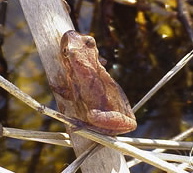Spring Peeper Fact Sheet

Spring Peepers are named for their signature high-pitched calls. This species is native to eastern North America and can be found from Manitoba, Canada to Florida. It is a woodland species that lives in areas with heavy plant growth near ponds, streams, or swamps. Peepers are typically found on the ground within leaf litter where they are well camouflaged. Within the forest ecosystem, these frogs have a role in controlling insect populations.
Appearance: Peepers are gray, tan or light brown in color with a light belly. They can be identified by the dark “X” on their backs and bands on the legs. The toes have flat pads that secrete a mucous, which acts as an adhesive to aid in climbing. An adult is between ¾ – 1 ¼ inches in length. Males can be distinguished from females by examining the throats; only the males have dark wrinkles showing the extra skin that will expand when calling.
Feeding: Spiders and a variety of small insects, such as ants, pill bugs or moth and butterfly larvae, are the primary sources of food for adult peepers. The larvae feed on algae while developing in the water.
Life History: The timing of breeding depends on spring temperatures, but generally begins in late February or March and continues into May. Males call to attract a mate and establish a territory. When a suitable mate is located, males grasp the females in a position known as amplexus. Eggs are fertilized by the males as they are laid and can be found attached to plants or leaf litter in shallow, woodland pools. Unlike many other frog species, spring peepers lay their egg singly, rather than in a mass. They will hatch within a few days (longer if temperatures are cool) and require 2-4 months to mature from tadpoles into frogs. Spring peepers are active from the end of winter until late fall when they dig into the soil to begin hibernation.
Sources and Additional Information:
“Spring Peeper”. Missouri Department of Conservation. 2014. Web. 1 July 2014. http://mdc.mo.gov/node/3067
Gordon, S.; M. Mingo and J. Hirst 1999. “Pseudacris crucifer” (On-line), Animal Diversity Web. Accessed July 01, 2014 at http://animaldiversity.ummz.umich.edu/accounts/Pseudacris_crucifer/
“Spring Peeper”. Rhode Island Vernal Pools, URI. Web. Accessed 2 July 2014. http://www.uri.edu/cels/nrs/paton/LH_spring_peeper.html
